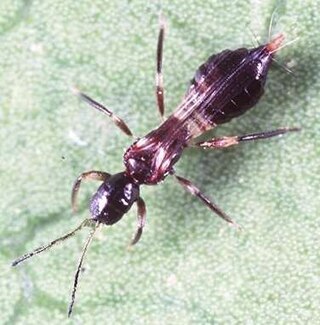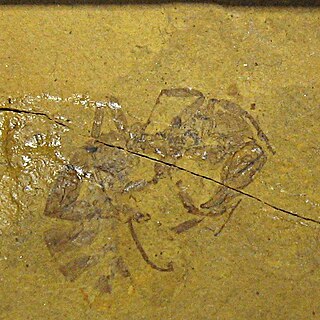
Fire ants are several species of ants in the genus Solenopsis, which includes over 200 species. Solenopsis are stinging ants, and most of their common names reflect this, for example, ginger ants and tropical fire ants. Many of the names shared by this genus are often used interchangeably to refer to other species of ant, such as the term red ant, mostly because of their similar coloration despite not being in the genus Solenopsis. Both Myrmica rubra and Pogonomyrmex barbatus are common examples of non-Solenopsis ants being termed red ants.

Formica is a genus of ants of the family Formicidae, commonly known as wood ants, mound ants, thatching ants, and field ants. Formica is the type genus of the Formicidae, and of the subfamily Formicinae. The type species of genus Formica is the European red wood ant Formica rufa. Ants of this genus tend to be between 4 and 8 mm long. Ants belonging to the Formica genus possess a single knob or bump located between their thorax and abdomen. These ants primarily feed on honeydew, a sugary liquid produced by aphids. Interestingly, Formica ants appear to take on a shepherding role with smaller aphids, relocating them to different parts of plants to ensure a continuous food source for the aphids. By doing so, the ants can establish a relatively sustainable honeydew supply for both themselves and their colony.

The Reduviidae is a large cosmopolitan family of the order Hemiptera. Among the Hemiptera and together with the Nabidae almost all species are terrestrial ambush predators; most other predatory Hemiptera are aquatic. The main examples of nonpredatory Reduviidae are some blood-sucking ectoparasites in the subfamily Triatominae. Though spectacular exceptions are known, most members of the family are fairly easily recognizable; they have a relatively narrow neck, sturdy build, and a formidable curved proboscis. Large specimens should be handled with caution, if at all, because they sometimes defend themselves with a very painful stab from the proboscis.

Macrothele is a genus of mygalomorph spiders in the family Macrothelidae, and was first described by A. Ausserer in 1871. Most species occur in Asia, from India to Japan, and Java, with five found in Africa, and two in Europe. The name is derived from Ancient Greek μακρός ("makro-"), meaning "big", and θηλή ("thele"), referring to the spinnerets.

Franklinothrips is a genus of thrips with pantropical distribution.

Kano's mole is a species of mole endemic to Taiwan. The specific name kanoana is derived from Tadao Kano, a Japanese naturalist who made the first record of these animals in 1940s.

Bagheera kiplingi is a species of jumping spider found in Central America, including Mexico, Costa Rica, and Guatemala. It is the type species of the genus Bagheera, which includes three other species, including B. prosper. B. kiplingi is notable for its peculiar diet, which is mostly herbivorous. No other known species of omnivorous spider has such a markedly herbivorous diet.
Ugandinella is a monotypic genus of Ugandan ant-mimicking jumping spiders containing the single species, Ugandinella formicula. It was first described by Wanda Wesołowska in 2006, and is found in Uganda. The name is derived from the type locality, and the species name refers to their appearance similar to members of Formicidae.

Prionomyrmex is an extinct genus of bulldog ants in the subfamily Myrmeciinae of the family Formicidae. It was first described by Gustav Mayr in 1868, after he collected a holotype worker of P. longiceps in Baltic amber. Three species are currently described, characterised by their long mandibles, slender bodies and large size. These ants are known from the Eocene and Late Oligocene, with fossil specimens only found around Europe. It is suggested that these ants preferred to live in jungles, with one species assumed to be an arboreal nesting species. These ants had a powerful stinger that was used to subdue prey. In 2000, it was suggested by Cesare Baroni Urbani that the living species Nothomyrmecia macrops and a species he described both belonged to Prionomyrmex, but this proposal has not been widely accepted by the entomological community. Instead, scientists still classify the two genera distinctive from each other, making Nothomyrmecia a valid genus.
Kachinus is an extinct genus of ant-like stone beetle in the family Staphylinidae containing the single species Kachinus antennatus.

Myrmeciites is an extinct form genus of bulldog ants in the subfamily Myrmeciinae of the family Formicidae, which contains three described species and two fossils not placed beyond the genus level. Described in 2006 from Ypresian stage deposits, all three of the described species and one unplaced fossil are from British Columbia, Canada, while the second unplaced fossil is from Washington State, USA. These ants were large, with the largest specimens collected reaching 3 centimetres (1.2 in). The behaviour of these ants would have been similar to extant Myrmeciinae ants, such as solitary foraging, nesting either in the soil or trees, and leaving no pheromone trail to food sources. Due to the poor preservation of these ants, their phylogenetic position among Myrmeciinae is unclear, and no type species has been designated. These ants are classified as incertae sedis in Myrmeciinae, but some writers have classified it as incertae sedis within the insect order Hymenoptera. This reclassification, however, has not been accepted; instead, Myrmeciites remains in Myrmeciinae.

Protanilla is a genus of subterranean ants in the subfamily Leptanillinae. Known from the Indomalayan realm, the genus contains about thirteen species. The genus was erected by Taylor (1990) for the type species P. rafflesi, described from workers from Peninsular Malaysia. Species in this genus have long and downcurved mandibles with peg-like tooth on the inner margins. Four species are known from China, one from Taiwan, one from Sri Lanka and a couple from India.

Dolopomyrmex is a genus of ants in the subfamily Myrmicinae containing the single species Dolopomyrmex pilatus.
Afromyrma is an extinct genus of ant in the formicid subfamily Myrmicinae, and is currently unplaced in any of the tribes of that subfamily. The genus contains a single described species, Afromyrma petrosa. Afromyrma is known from a single Upper Cretaceous fossil, which was found in Orapa in the Central District of Botswana.
Afropone is an extinct genus of ant in the formicid subfamily Ponerinae, and is currently unplaced in any of the tribes of that subfamily. The genus contains two described species, Afropone oculata and Afropone (?) orapa. Afropone is known from a group of Upper Cretaceous fossils, which were found at Orapa in the Central District of Botswana.

Formicodiplogaster is an extinct form genus of nematodes in the family Diplogasteridae which currently includes a single described species Formicodiplogaster myrmenema. The species is known from early Miocene fossils found on Hispaniola. F. myrmenema has been preserved in association with Azteca alpha, one of only two known fossil species in the ant genus Azteca.

Casaleia is an extinct genus of ants in the formicid subfamily Amblyoponinae described by Pagliano & Scaramozzino in 1990 from fossils found in Europe. The genus contains four species dating from the Eocene to Miocene, Casaleia eocenica, Casaleia inversa, Casaleia longiventris, Casaleia orientalis.

Yantaromyrmex is an extinct genus of ants first described in 2013. Members of this genus are in the subfamily Dolichoderinae of the family Formicidae, known from Middle Eocene to Early Oligocene fossils found in Europe. The genus currently contains five described species, Y. constrictus, Y. geinitzi, Y. intermedius, Y. mayrianum and Y. samlandicus. The first specimens were collected in 1868 and studied by Austrian entomologist Gustav Mayr, who originally placed the fossils in other ant genera until the fossils were reviewed and subsequently placed into their own genus. These ants are small, measuring from 4 to 6 mm in length and can be characterized by their trapezoidal shaped head-capsules and oval compound eyes that are located slightly to the rear of the capsules midpoint, with no known ocelli present.

Messelepone is an extinct genus of ants in the formicid subfamily Ponerinae described from fossils found in Europe. M. leptogenoides is the only species assigned to the genus, which is one of several Lutetian Ponerinae genera.

Gerontoformica is an extinct genus of stem-group ants. The genus contains thirteen described species known from Late Cretaceous fossils found in Asia and Europe. The species were described between 2004 and 2016, with a number of the species formerly being placed into the junior synonym genus Sphecomyrmodes.















